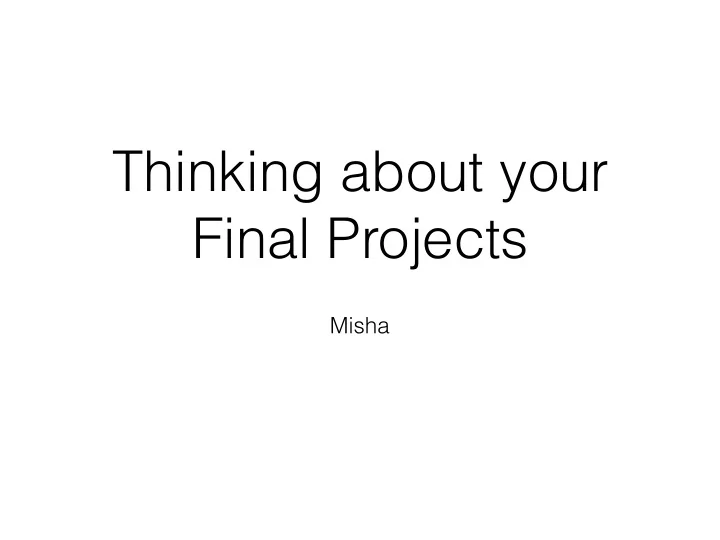

Thinking about your Final Projects Misha
Why Start Now? • Mentor check-ins start early in the second half of the semester • Opportunity to: • review literature • have ideas in your head • find partners • 30% of your final grade
Types of Projects • Model: • propose a new model, analyze it, and test it on several tasks for validation • Task: • use available tools to try and do as well as possible on a certain task • Analysis: • analyze existing models or tasks to understand what they tell us
Example of Model Project • Yang, Lu, & Zheng. A Simple Regularization-based Algorithm for Learning Cross-Domain Word Embeddings. EMNLP 2017. • Motivate and describe their model: • Learn small-corpus embeddings via transfer learning • Use existing large-corpus embeddings as regularization • Evaluate the model’s usefulness on several tasks: • Entity recognition • Sentiment analysis
Model Project Details • Models should be well-founded: major design decisions should have some linguistic or mathematical motivation. • Models will most-likely build upon existing work, and so must be placed in that context. • Empirical verification should be conducted on model assumptions, not just downstream tasks. • Models can help improve performance on downstream tasks by augmenting existing methods.
Example of Task Project • Herbelot & Baroni. High-risk learning: Acquiring new word vectors from tiny data. EMNLP 2017. • Motivate and describe the task: • Learn a word vector using only the word’s definition and vectors of other words. • Simulates one-shot learning of word embeddings when we don’t have enough data about a word but still want to represent it. • Devise a method to do well on this task: • Modify word2vec algorithm to learn quickly from one example. • Compare method to baseline/previous methods.
Task Project Details • If introducing a task, need to show that previous tasks are insufficient and come up with baseline methods. • If approach performs better/worse than existing methods, give some reasons as to why. • Be careful not to overfit - i.e. devise a method that only works well on your model because you have been evaluating using the test set.
Example of Analysis Project • Chen, Bolton, & Manning. A Thorough Examination of the CNN/ Daily Mail Reading Comprehension Task. ACL 2016. • Describe what they analyze and demonstrate its importance: • Reading comprehension is an important goal in NLP • Efforts often evaluated on the CNN/Daily Mail task, appealing due to its size and simplicity • Perform the analysis and gain new insights: • Design a very simple system that does well on the task, indicating that it is perhaps too easy • Doing better than the state-of-the-art may be impossible due to annotation/co-reference errors in the original task
Analysis Project Details • Choose an existing model/task for which you believe present understanding is insufficient. • Sometimes goal is to ‘break’ the model or show that the task may not be that useful by demonstrating points of failure. • If the outcome is negative for the subject of consideration, try to introduce alternatives.
Closing Thoughts • Project categories have a lot of overlap and good reports will often have components of each. • Negative results are okay, but hopefully they lead to better understanding. • Attend the many NLP colloquia this spring (see course schedule for times).
Recommend
More recommend